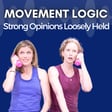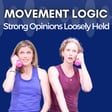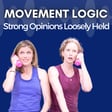
Episode 25: Got Yoga Butt? Now What?
Welcome to Episode 25 of the Movement Logic podcast! In this solo episode, Laurel shares her history with yoga butt, or, proximal hamstring tendinopathy (high hamstring pain.) This episode is packed with tendon and muscle physiology. It also busts the big myth that yoga butt (and any yoga-related injury) is because we’re all woefully “overstretched”. At the end, Laurel shares a 3-step approach to nipping yoga butt in the yoga bud using strength training knowledge and tools.
Additionally Laurel examines:
- What yoga butt is (hint: a pain in the butt right at the sit bone more technically referred to as proximal hamstring tendinopathy).
- What a tendinopathy is.
- Short and sweet hamstring anatomy.
- Why yoga students might be more likely to experience PHT.
- That a typical vinyasa or Iyengar-inspired asana class involves a whole bunch of passive forward bends/hamstring stretching and why that makes managing and overcoming yoga butt tough for students in those classes.
- How Laurel nipped her yoga butt in the bud.
- The contradictory advice yoga teachers (including Laurel!) gave about what to do about yoga butt.
- How proximal hamstring tendon compression (rather than tension) plays a role in causing or exacerbating PHT.
- How strength training can help students overcome and avoid yoga butt.
- Why the narrative that we’re overstretched is illogical and a distraction away from the solution.
- What motor units are, what muscle recruitment is, and how understanding this aspect of muscle physiology can explain why yoga asana won’t make your tendons stronger but strength training will.
- A 3-step process to overcoming yoga butt as well as encouragement to see a clinician if what you try doesn’t seem to help.
Reference links:
Get the Hip & SI Joint tutorial before the cart closes this Sunday 11/27/22: https://movementlogictutorials.com/movement-logic/hips-tutorial/
If you want to stretch your hamstrings please continue to do so
Ebonie Rio - Isometric exercise in tendinopathy
Putting “Heavy” into Heavy Slow Resistance
Do we need to think about connective tissues when strength training?
Sign up here for the Movement Logic Newsletter for course discounts and sales and receive a free mini Pelvic Floor course!
Watch the video of this conversation at: www.movementlogictutorials.com/podcast
Want more Movement Logic?
- Follow us on IG: @movementlogictutorials
- Get on our mailing list for tons of free content
- Contact us (we're super friendly)
Thanks for listening!


